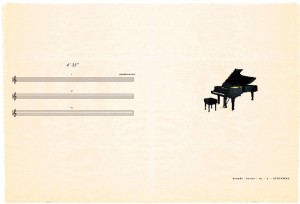John Milton Cage Jr, best known for his 1952 composition 4’33’’ is the perfect example for listening to the things or sounds surrounding oneself. Performed in the absence of deliberate sound, Cage himself is simply present in the room for the specific 4 minutes and 33 seconds. Leaving the audience in suspense as they listen to the echo of the environment surrounding them, it gives them no choice other than to notice things. The art of noticing things is extraordinary, as one can directly focus on these “incidental sounds” without a sole distraction. Hearing the clock ticking on the wall, feeling the person next to you shuffling in their seat, realisation of your own impatient tapping of your foot as you wait; are all signs of the affect of a prolonging silence.
“Wherever we are, what we hear is mostly noise. When we ignore it, it disturbs us. When we listen to it, we find it fascinating.”
After remaining silent in the lectorial for an excruciating 33 seconds and instructed to think about the intention of the silence, all I could notice was my impatience in sitting still, my clicking of a pen, fiddling of my fingers and occasional yawning. This leads me to think that if it only takes 33 seconds to notice these things about myself, how long would it take to notice other peoples’ behaviour and mannerisms in an attempt to understand others? What does it take to have silence? Being silent outlines that as human beings there is no such thing, something is always happening, looking at the grand scheme of things, people are always moving, there will never be an absolute moment of silence in this day and age. We are so overrun by communication and technology that we don’t take the time to notice what is happening around us.
Image sourced from : http://www.ruthong.com/80011/809809/home/spec-wk-steinway-crackerjack-montreal-tomtom-china
Quote sourced from: John Cage, “The future of music: Credo”, Silence, p. 3.

Leave a Reply